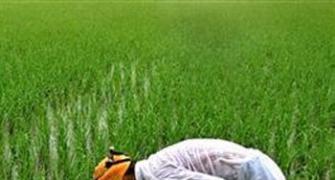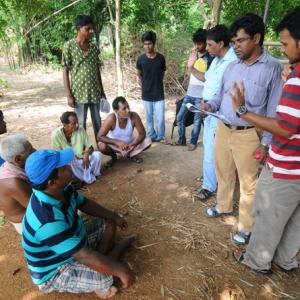Poor rainfall has also depleted water reservoirs levels, which is likely to impact the winter crops.
 All signs point to the growing distress in rural areas. The rainfall deficit currently stands at 15 per cent of its long-term average.
All signs point to the growing distress in rural areas. The rainfall deficit currently stands at 15 per cent of its long-term average.
If the situation persists, this year's monsoon could end up being the worst in nearly three decades, say experts. Poor rainfall has also depleted water reservoirs levels, which is likely to impact the winter crops.
If the collapse of commodity prices, lower hikes in minimum support prices, and the sharp moderation in rural wage growth are factored in, then the outlook for rural areas, particularly agriculture, which employs nearly half of India's workforce, looks grim.
Yet the headline growth numbers for agriculture released by the Central Statistical Organisation (CSO) show the sector grew at 1.9 per cent in the first quarter of the current financial year. So, is the situation as bad as reports suggest?
The CSO's estimates show the production of rice, wheat, coarse cereals and pulses contracted eight per cent, 7.2 per cent, 1.4 per cent and 12.8 per cent, respectively, during the rabi season of agriculture year 2014-15 (ended in June 2015).
Among the commercial crops, the production of oilseeds declined by 17.6 per cent during the rabi season of 2014-15.
However, these declines in crop production were offset by the livestock, forestry and fisheries segment, which grew at six per cent in the first quarter.
The high growth of this non-crop segment, which accounts for 41 per cent of gross value added (GVA) in the agricultural sector offset the declines in the crop production and pushed up the headline growth number.
The share of this non-crop segment in agriculture has, in fact, been steadily rising over the past few years.
According to the new GDP series, the GVA of the non-crop sector in total agricultural sector grew from 34.5 per cent in 2011-12 to 35.5 per cent in 2013-14. Data for 2014-15 is yet to be released.
Thus, while crops continue to account for about 60 per cent of total agricultural income, the non-crop segment now accounts for a significant and growing share of total income generated in the sector.
Are headline agricultural growth numbers misleading? This suggests strong growth of this segment could push up the headline numbers masking the agrarian distress on the ground.
"Last year, we had suboptimal production in both kharif and rabi. Yet, the sector showed positive rates of growth. Clearly, growth is coming from non-conventional sources. So it is possible this could happen again," says Madan Sabnavis, chief economist at CARE.
Pronab Sen, chairman, National Statistical Commission, concurs: "These segments have a growth trajectory of their own, which does not get affected by monsoons. Horticulture gets affected. But even if crop production is negative, overall growth can be positive."
Similarly, drawing inferences on crop production from the latest crop sowing data, too, would be misleading.
The latest crop sowing data suggest that sown acreage has been robust. In a recent research note, CARE had noted: "Area sown under pulses is increasing significantly as farmers plant short duration pulses that will give good harvest even under drought-like situations. Hence, the area sown is likely to grow further and cross its normal mark if the current monsoon situation persists."
Based on this, Sabnavis argues: "Crop production might turn out to be higher than last year. The sowing area is typically a good indicator as yields per hectare do not change annually. They change in the long run. Thus, more acreage, more production."
 But this data, too, could be masking the extent of rural distress on the ground.
But this data, too, could be masking the extent of rural distress on the ground.
The problem with relying exclusively on this crop sowing data is that because of early rains, there was a flurry of sowing initially.
But monsoons subsequently failed in the second half of July and August and in the absence of firm data, it is difficult to ascertain its effect on crop output.
While data show planting has been completed on 96 per cent of the normal area sown under kharif crops and an area that is two per cent larger than in 2014, Aditi Nayar, senior economist at Icra, contends: "This might be disguising the adverse impact of the growing deficit of monsoon rainfall on crop yields."
It would, thus, be prudent to wait for the second advance estimates of crop production to get a better understanding of the situation on the ground rather than relying on sowing data to estimate production levels and estimate the extent of rural distress.
While we might already be in a situation of rural distress, Sen says this time around, "There are more shock absorbers than before. Mahatma Gandhi National Rural Employment Guarantee Act (MGNREGA) for one will be critical and construction could play a big role."
Perhaps in anticipation of heightening of rural distress, the Cabinet has approved a proposal to provide 50 days of work for a member of each household under MGNREGA, in addition to the current 100 days.










